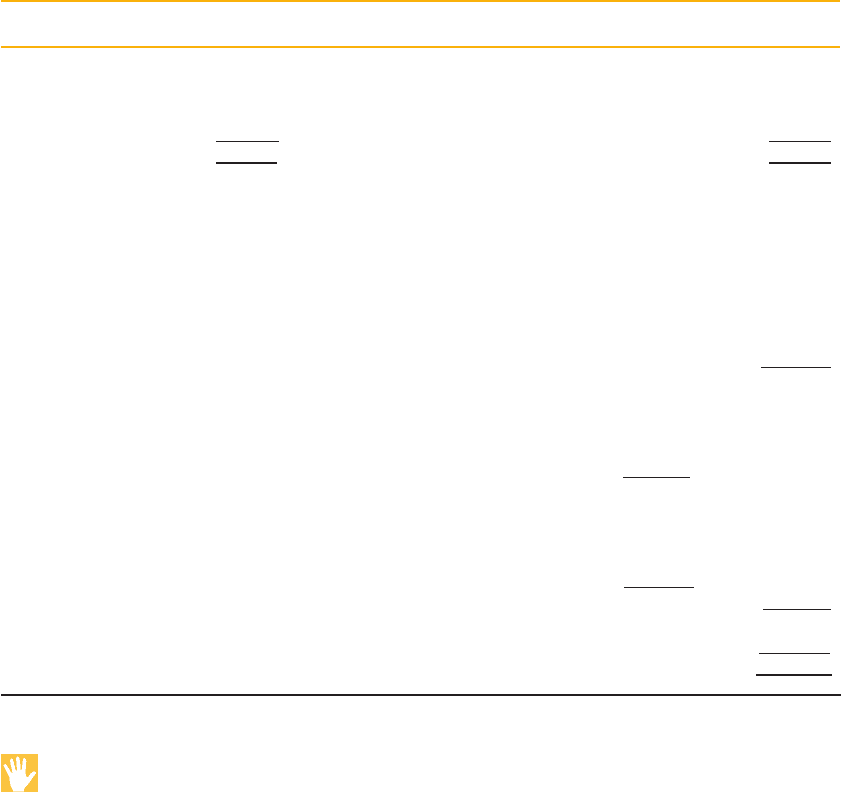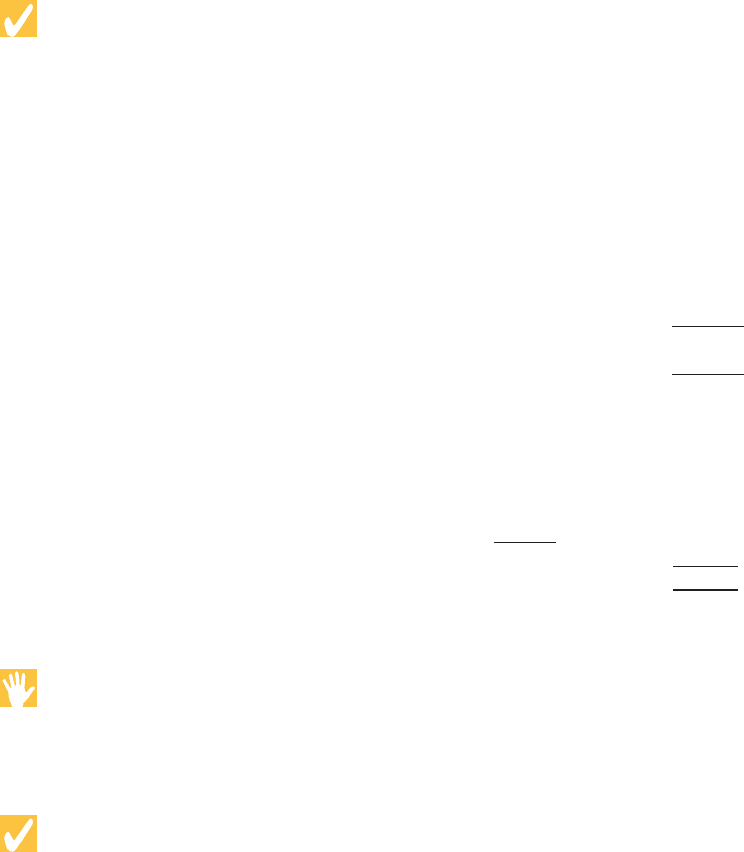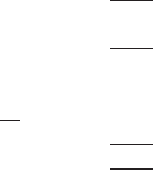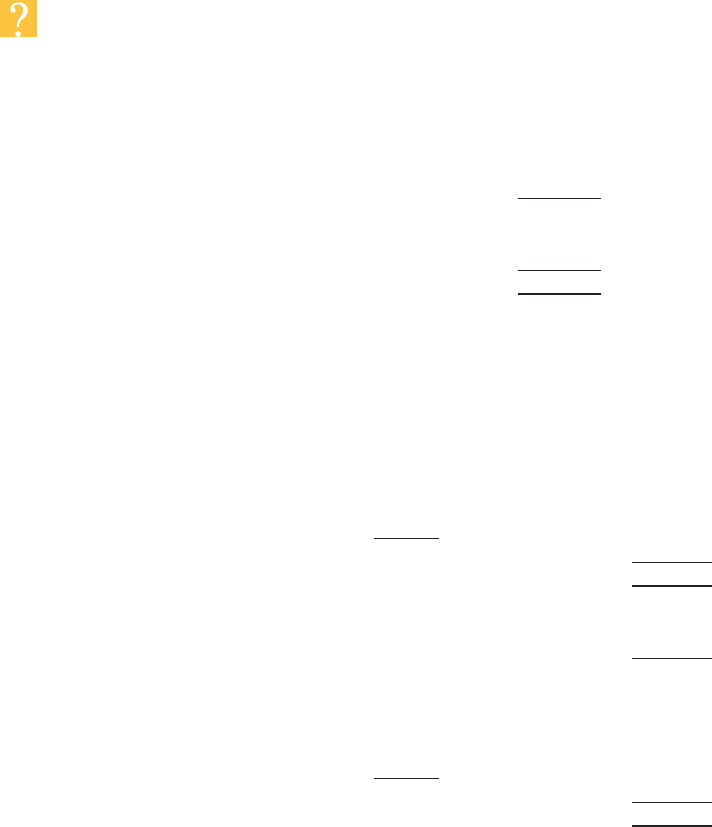CIMA CO2 Official Learning System - Fundamentals of Financial Accounting
Подождите немного. Документ загружается.


STUDY MATERIAL C2
450
THE FINANCIAL STATEMENTS OF LIMITED COMPANIES AND THE STATEMENT OF CASH FLOWS
Solution
Its cash generated from operations for year 2 would be as follows:
$
Operating profi t 59,000
Add:
Depreciation 10,000
Loss on disposal of non-current assets 4,000
Decrease in inventories 10,000
Increase in payables 2,000
Less: increase in receivables (4,000)
Cash generated from operations 81,000
13.3.4 Cash flows from operating activities – net cash
from operating activities
We now need to calculate the cash from operating activities by deducting the following
items from cash generated from operations:
(a) interest paid;
(b) tax paid;
Note that in both cases, it is the sum actually paid during the period that is included. In
the case of tax, this will often be last year’s tax liability.
13.3.5 Cash flows from investing activities
This section of the statement of cash fl ows shows the purchase of non-current fi xed assets
and the proceeds on their disposal. Whilst in practice all the relevant information would
be known, in the computer-based assessment it is quite common for a question to give you
only part of the information, and you have to calculate the missing information. An exam-
ple of this is shown below relating to the purchase/sale of a non-current asset.
The interest and dividends received is straight forward and you can fi nd these fi gures in
the statement of comprehensive income.
13.3.6 Cash flows from financing activities
This section of the statement of cash fl ows shows the proceeds from issuing shares. A
computer-based assessment question will often not tell you that shares have been issued;
you have to work this out by looking to see if the ordinary or preference share capital has
increased. Similarly, you will have to look at any debentures or loans to see if they have
increased, in which there will be a cash fl ow in, or if they have decreased, in which case
there will be a cash fl ow out.
The payment of dividends will be found in the statement of changes in equity. This
fi gure will normally be the cash paid to shareholders in the year. However, you should check
to see if there is an accrual for dividends under current liabilities in the statement of fi nan-
cial position.

451
FUNDAMENTALS OF FINANCIAL ACCOUNTING
THE FINANCIAL STATEMENTS OF LIMITED COMPANIES AND THE STATEMENT OF CASH FLOWS
If there is, this means that the directors have declared a dividend before the year end,
but paid it after the year end. If this is the case, then you will have to work out what cash
was actually paid to the shareholders for dividends. This is similar to the treatment of taxa-
tion and an example is given below.
Example 13.F
Continuing from Example 13.E, suppose that the dividends in the statement of changes in equity was $30,000
and that other items on the statements of fi nancial position were as follows:
Year 1 ($) Year 2 ($)
Non-current assets *
Plant at cost 100,000 120,000
Acc. depreciation (20,000) (22,000)
80,000 98,000
Current assets
Bank and cash 63,000 101,000
Share capital 100,000 120,000
Non-current liabilities
Debenture 30,000 21,000
Current liabilities
Taxation 12,000 16,000
Dividends 20,000 30,000
*Plant which had cost $15,000 and had a carrying amount of $7,000 was sold during the year.
Notice that the plant at cost has increased by $20,000 although we know that an asset with a cost of $15,000
has been sold. This means that an asset must have been purchased for $35,000. Similarly, notice that the depre-
ciation given in the statement of comprehensive income was $10,000 – and yet the accumulated depreciation
in the statement of fi nancial position has increased by only $2,000. This is because the accumulated deprecia-
tion on the asset sold must have been $8,000. There must have been an asset sold during the year, and its cost
and depreciation will have been taken out of the ledger accounts. Refer back to Chapter 6 to revise the ledger
accounts for disposals of non-current assets. If the plant had a carrying amount of $7000 and it was sold at a
loss of $4,000, then the proceeds must have been $3,000. Thus we have been able to work out the missing
information of how much was received when the plant was sold. We can reconstruct the relevant non-current-
asset accounts as follows:
Plant at cost
$$
Opening balance b/d 100,000 Disposal 15,000
Purchases (balancing fi gure)
35,000 Closing balance c/d 120,000
135,000 135,000

STUDY MATERIAL C2
452
THE FINANCIAL STATEMENTS OF LIMITED COMPANIES AND THE STATEMENT OF CASH FLOWS
Plant disposals
$$
Plant at cost 15,000 Plant depreciation 8,000
Loss on disposal 4,000
Proceeds of sale (balancing fi gure) 3,000
15,000 15,000
We can now prepare the statement of cash fl ows for the year ended year 2 as follows:
$$
Cash fl ow from operating activities
Cash generated from operations (from example 13.E above) 81,000
Less: interest paid (3,000)
Less: tax paid (i.e. last year’s) (12,000)
Net cash from operating activities 66,000
Cash fl ows from investing activities
Proceeds of sale of non-current assets 3,000
Less: payments to acquire non-current assets (35,000)
Interest received 13,000
Net cash used in investing activities (19,000)
Cash fl ows from fi nancing activities
Equity dividends paid (i.e. last year’s) (20,000)
Proceeds from issue of shares 20,000
Less: repayment of debentures (9,000)
Net cash used in fi nancing activities (9,000)
Net increase in bank and cash 38,000
Bank and cash at the beginning of the period 63,000
Bank and cash at the end of the period 101,000
Exercise 13.2
From the following information, construct a statement of cash fl ows:
$
Operating profi t for the year, after charging depreciation of $22,300 215,500
Purchase of non-current assets during the year 80,000
Repayment of non-current loan 45,000
Issue of shares at par 100,000
Changes in working capital during the year
Increase in inventories 22,500
Decrease in receivables 18,000
Decrease in payables 14,500
Taxation paid 25,000
Dividends paid 5,000

453
FUNDAMENTALS OF FINANCIAL ACCOUNTING
THE FINANCIAL STATEMENTS OF LIMITED COMPANIES AND THE STATEMENT OF CASH FLOWS
Solution
Statement of cash fl ows
$
Cash fl ows from operating activities
Operating profi t 215,500
Add :
Depreciation 22,300
Decrease in receivables 18,000
Less :
Increase in inventories (22,500)
Decrease in payables (14,500)
Cash generated from operations 218,800
Taxation paid (25,000)
193,800
Cash fl ows from investing activities
Purchase of non-current assets (80,000)
Cash fl ows from fi nancing activities
Issue of shares 100,000
Loan repaid (45,000)
Dividends paid (5,000)
50,000
Net increase in cash 163,800
Exercise 13.3
List as many examples as you can of cash fl ows in or out of a business that do not affect
profi t for the period.
Solution
●
Cash fl ows in – shares issued, loans received, proceeds of sale of non-current assets
(as opposed to profi t on disposal) and reduction in receivables ’ balances due to monies
being received.
●
Cash fl ows out – dividends paid, loans repaid, non-current assets purchased and reduc-
tion in payables ’ balances due to monies being paid out.
13.3.7 Statement of cash flows for sole traders
The preparation of a statement of cash fl ows is not restricted to limited companies. Indeed,
the statement is a useful source of information for any kind of organisation.
For sole traders, dividends would be replaced by cash drawings, and share capital issued
would be replaced by cash introduced by the owner. Taxation would not appear at all,
STUDY MATERIAL C2
454
THE FINANCIAL STATEMENTS OF LIMITED COMPANIES AND THE STATEMENT OF CASH FLOWS
being a private transaction. Otherwise, the preparation of the statement of cash fl ows
would follow the same principles as for limited companies.
13.4 Summary
In this chapter we have looked at:
●
the preparation of fi nancial statements for limited companies;
●
the preparation of a statement of changes in equity;
●
the treatment of certain transactions in the fi nancial statements of companies:
– taxation,
– other comprehensive income,
– the revaluation of property,
– dividends,
– debentures,
– reserves.
●
the bookkeeping entries to record the issue of shares;
●
the preparation of a cash fl ow statement;
●
why profi t does not equal cash fl o w .

455
Question 1 Multiple choice
1.1 Revenue reserves are:
(A) accumulated and undistributed profi ts of a company.
(B) amounts that cannot be distributed as dividends.
(C) amounts set aside out of profi ts to replace revenue items.
(D) amounts set aside out of profi ts for a specifi c purpose.
1.2 A company has $100,000 of ordinary shares at a par value of 10¢ each and 100,000
5 per cent preference shares at a par value of 50¢ each. The directors decided to
declare a dividend of 5¢ per ordinary share.
The total amount to be paid out in dividends amounts to:
$...............
1.3 The correct ledger entries needed to record the issue of 200,000 $1 shares at a pre-
mium of 30¢, and paid for by cheque, in full, would be:
Debit Credit
$ $
Share premium
Share capital
Bank
1.4 A company has authorised share capital of one million ordinary shares of $1 each,
of which 800,000 have been issued at a premium of 50¢ each, raising capital of
$1,200,000. The directors are considering allocating $120,000 for dividend pay-
ments this year. This amounts to a dividend of:
$............... per share
Revision Questions
13
REVISION QUESTIONS C2
456
THE FINANCIAL STATEMENTS OF LIMITED COMPANIES AND THE STATEMENT OF CASH FLOWS
1.5 Which one of the following would you expect to fi nd in the statement of changes in
equity in a limited company for the current year?
(A) Ordinary dividend proposed during the current year, but paid in the following
year.
(B) Ordinary dividend declared during the current year, but paid in the following
year.
(C) Directors ’ fees.
(D) Auditors ’ fees.
1.6 A business has made a profi t of $8,000 but its bank balance has fallen by $5,000.
This could be due to:
(A) depreciation of $3,000 and an increase in inventories of $10,000.
(B) depreciation of $6,000 and the repayment of a loan of $7,000.
(C) depreciation of $12,000 and the purchase of new non-current assets for
$25,000.
(D) the disposal of a non-current asset for $13,000 less than its carrying amount.
1.7 A company has authorised capital of 50,000 5 per cent preference shares of $2 each
and 500,000 ordinary shares with a par value of 20¢ each. All of the preference
shares have been issued, and 400,000 ordinary shares have been issued at a pre-
mium of 30¢ each. Interim dividends of 5¢ per ordinary share plus half the prefer-
ence dividend have been paid during the current year. A fi nal dividend of 15¢ per
ordinary share is declared and half the preference dividend. The total of dividends
payable for the year is:
$...............
1.8 A business’s bank balance increased by $750,000 during its last fi nancial year. During
the same period it issued shares of $1 million and repaid a debenture of $750,000.
It purchased non-current assets for $200,000 and charged depreciation of $100,000.
Working capital (other than the bank balance) increased by $575,000. Its profi t for the
year was:
$...............
1.9 The record of how the profi t or loss of a company has been allocated to dividends
and reserves is found in the:
(A) capital account.
(B) statement of comprehensive income.
(C) reserves account.
(D) statement of changes in equity.
1.10 Revenue reserves would decrease if a company:
(A) sets aside profi ts to pay future dividends.
(B) transfers amounts into ‘ general reserves ’ .
(C) issues shares at a premium.
(D) pays dividends.

457
FUNDAMENTALS OF FINANCIAL ACCOUNTING
THE FINANCIAL STATEMENTS OF LIMITED COMPANIES AND THE STATEMENT OF CASH FLOWS
1.11 A business can make a profi t and yet have a reduction in its bank balance. Which
one of the following might cause this to happen?
(A) The sale of non-current assets at a loss.
(B) The charging of depreciation in the statement of comprehensive income.
(C) The lengthening of the period of credit given to customers.
(D) The lengthening of the period of credit taken from suppliers.
1.12 Which one of the following does not form part of the equity capital of a limited
company?
(A) Debentures.
(B) Share premium.
(C) Revaluation reserve.
(D) Ordinary share capital.
1.13 A particular source of fi nance has the following characteristics: a fi xed return, a
fi xed repayment date, it is secured and the return is classifi ed as an expense.
Identify the source of fi nance:
(A) Ordinary share.
(B) Bank overdraft.
(C) Debenture.
(D) Preference share.
1.14 Extracts from the fi nancial statements of CFS Ltd are set out below.
Statement of comprehensive income CFS Ltd for the year ended 31 December 20X8
$’000 $’000
Turnover 300
Cost of sales (150)
Gross profi t 150
P r o fi t on sale of non-current asset 75
225
Expenses 15
Depreciation 30
(45)
Net profi t 180
Balances as at 31 December
20X7 20X8
$’000 $’000
Inventories, receivables, current liabilities (net) 40 50
What fi gure would appear in the statement of cash fl ows of CFS Ltd for the year
ended 31 December 20X8 in respect of cash generated from operations?
$...............

REVISION QUESTIONS C2
458
THE FINANCIAL STATEMENTS OF LIMITED COMPANIES AND THE STATEMENT OF CASH FLOWS
1.15 The movement on the plant and machinery account for X Ltd is shown below:
$
Cost b/f 10,000
Additions 2,000
Disposals (3,000)
Cost c/f 9,000
Acc. Depreciation b/f 2,000
Charge for the year 1,000
Disposals (1,500)
Acc. Depreciation c/f 1,500
Carrying amount b/f 8,000
Carrying amount c/f 7,500
The profi t on the sale of the machine was $500. What fi gures would appear in the
statement of cash fl ows of X Ltd?
(A) Movement on plant account $500 and profi t on disposal of $500.
(B) Movement on plant account $500 and proceeds on sale of plant $2,000.
(C) Purchase of plant $2,000 and profi t on disposal of $500.
(D) Purchase of plant $2,000 and proceeds on sale of plant $2,000.
1.16 ‘Other comprehensive’ income is found in the:
(A) Statement of fi nancial position.
(B) Statement of cash fl ows.
(C) Statement of changes in equity.
(D) Income statement.
(E) The ledger accounts.
(F) None of these.
1.17 ‘The revaluation of a property is shown:
(A) Property in the statement of fi nancial position, comprehensive income and
revaluation reserves.
(B) Property in the statement of fi nancial position, statement of changes in equity
and revaluation reserves.
(C) Property in the statement of fi nancial position, income statement and revalua-
tion reserves.
(D) None, as companies are not allowed to revalue property.
1.18 ‘The tax on the gain on the revaluation of property is shown in the:
(A) Property account.
(B) Revaluation reserve.
(C) Statement of change in equity.
(D) Statement of comprehensive income.

459
FUNDAMENTALS OF FINANCIAL ACCOUNTING
THE FINANCIAL STATEMENTS OF LIMITED COMPANIES AND THE STATEMENT OF CASH FLOWS
1.19 ‘ Which of the following statements is false with regard to limited companies?
(A) Limited companies are not allowed to report an income statement.
(B) Limited companies must report total comprehensive income.
(C) Limited companies must report ‘other comprehensive income’.
(D) There are two alternative formats for presenting comprehensive income.
1.20 ‘An income statement includes the following line items:
(A) Sales to gross profi t.
(B) Sales to operating profi t.
(C) Sales to profi t before tax.
(D) Sales to profi t for the period.
Question 2
Omit Ltd has the following statement of comprehensive income for the year ended
31 December 20X1 (draft):
$
Sales 1,210,213
Cost of sales (943,000)
Gross profi t 267,213
Administrative salaries (110,100)
Other expenses (28,956)
P r o fi t for the period 128,157
Omit Ltd has the following statement of fi nancial position as at 31 December 20X1 (draft):
Assets $ $ $
Non-current assets 596,294
Current assets
Inventories 186,200
Receivables 252,111
Cash 87,800
526,111
1,122,405
Equity and liabilities
Share capital 100,000
Retained earnings 878,342
978,342
Current liabilities
Trade payables 120,290
Employee income tax 13,205
Social security tax 10,568
144,063
1,122,405
